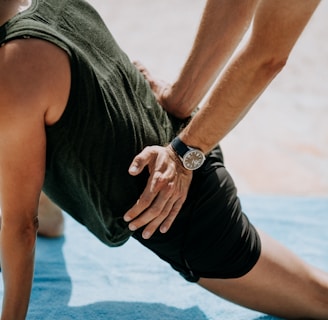Understanding Back Pain in the Gym: Causes, Types, and Rehabilitation
REHABILITATION
11/26/20245 min read


The Causes of Back Pain in the Gym
Back pain in the gym can arise from several factors, primarily revolving around improper lifting techniques and lack of awareness of one’s physical limits. One significant contributor to back injuries is poor form during exercises such as deadlifts and squats. Lifting heavy weights without proper technique can place excessive strain on the spinal structures, leading to acute injuries. For instance, rounding the back during a deadlift may result in herniated discs or muscular strain, demonstrating the importance of adhering to correct lifting protocols.
Another crucial aspect involves overtraining. When individuals push their bodies beyond their capacity without allowing necessary recovery, fatigue sets in. This fatigue can alter mechanics during workouts, increasing the risk of injury. Overtraining can also exacerbate muscle imbalances; these imbalances occur when specific muscle groups become disproportionately stronger or weaker, thereby placing uneven stress on the back. For example, a stronger anterior chain may pull the pelvis forward, resulting in strain on the lower back.
Prior injuries also play a significant role in susceptibility to back pain during gym sessions. Individuals with a history of back pain may be predisposed to re-injury, especially if they resume intense training too quickly or neglect rehabilitation exercises. Furthermore, external factors such as inappropriate footwear, lack of a proper warm-up, and unsafe gym environments can substantially affect back health. Wearing unsupportive shoes can compromise overall posture, leading to further complications.
In summary, understanding the multifaceted causes of back pain in the gym is essential for prevention and effective rehabilitation. By addressing improper techniques, managing training loads, considering previous injuries, and optimizing the gym environment, individuals can enhance their workout experience while reducing the risk of back injuries.
Types of Back Pain: Acute vs. Chronic
Back pain is a prevalent issue among gym-goers, and understanding the types is essential for effective management and rehabilitation. Back pain generally falls into two categories: acute and chronic. Acute back pain typically occurs suddenly and can result from injuries or strains during physical activities. For instance, exercises that involve heavy lifting, such as deadlifts or squats, can lead to abrupt pain due to improper form or excessive weight. Sprains and muscle strains during activities like bench pressing or jumping can also trigger acuteness in back pain. The pain associated with acute injuries often subsides within a few days to weeks, provided that proper rest and care are employed.
In contrast, chronic back pain is persistent, lasting for more than three months. This type usually arises from the continuous strain placed on the spine from repetitive movements or inadequate core support during workouts. For instance, failing to engage the core while performing exercises, such as kettlebell swings or overhead presses, can lead to long-term stress on vertebrae and muscles. This continuous pressure contributes to wear and tear, ultimately causing ongoing discomfort. Chronic back pain may also be compounded by psychological factors, including anxiety and depression, often stemming from the constant pain experienced. Addressing these underlying issues is crucial for an effective rehabilitation strategy.
Understanding the differences between acute and chronic back pain is vital for developing targeted rehabilitation plans. While acute pain might necessitate immediate intervention and modification of activities, chronic pain could require a more comprehensive approach, including strength training, flexibility exercises, and psychological support. By recognizing the type of back pain one is experiencing, individuals can better navigate their treatment options and improve recovery outcomes.
Visit us at thedailyfitness.in for successful rehabilitation of your back pain.
The Importance of Core Stability
Core stability plays a crucial role in preventing and rehabilitating back pain, acting as the foundation for effective movement during physical activities. A strong core is essential for maintaining proper posture, supporting the spine, and promoting alignment in various exercises. To understand the interconnectedness of core strength and back pain, it is vital to recognize the different components that constitute the core, which includes the abdominal muscles, back muscles, and pelvic floor.
The abdominal muscles, particularly the rectus abdominis, obliques, and transversus abdominis, are integral to maintaining stability. These muscles work in concert to create a strong support system for the spine. Similarly, the muscles of the lower back, particularly the erector spinae, contribute to spinal stability and help prevent injury by absorbing impact during movement. The pelvic floor also plays a pivotal role in core stability, providing necessary support to the abdominal and pelvic organs and aiding in overall stability during various physical activities.
Incorporating core stability exercises into workout routines can significantly reduce the risk of back pain. Exercises such as planks, bridges, and bird-dogs target these muscle groups effectively, enhancing strength and stability. It is crucial to perform these exercises with correct form to maximize benefits and prevent injuries. Integrating core stability training into a regular fitness regimen can help improve athletic performance, enhance overall strength, and protect against injury by ensuring that the body is well-aligned and functioning efficiently.
Moreover, individuals should consider gradually introducing these exercises, focusing on quality over quantity. Working with fitness professionals who can provide guidance and monitor progress is often beneficial. Developing a strong core not only aids in reducing back pain but also promotes longevity and overall well-being in fitness pursuits.
Rehabilitation: The McGill Big 3 Exercises
The McGill Big 3 exercises comprise a set of three specific movements designed to improve core stability and alleviate back pain. These exercises, known as the McGill Curl-Up, Side Plank, and Bird-Dog, serve as foundational elements in a rehabilitation program aimed at enhancing spinal health and reducing discomfort during physical activities.
The first exercise, the McGill Curl-Up, primarily targets the rectus abdominis and helps strengthen the anterior core without placing excessive strain on the lumbar spine. To perform this exercise, lie on your back with one knee bent while keeping the other leg straight. Place your hands under your lower back for support, and lift your head and shoulders off the ground while maintaining the pelvic position. Hold briefly before returning to the starting position. This controlled movement not only builds core strength but also teaches proper alignment and muscular coordination, essential for individuals with back pain.
The second exercise, the Side Plank, focuses on the obliques and further enhances core stability. Begin by lying on your side, supporting your body weight on your forearm. Stack your legs and lift your hips off the ground, creating a straight line from head to toe. Aim to hold this position for a designated amount of time, gradually increasing the duration as strength improves. This exercise is particularly effective in preventing lateral instability, which is crucial for maintaining a healthy spine.
Lastly, the Bird-Dog exercise engages both the anterior and posterior chains, promoting balance and coordination. To execute this movement, position yourself on all fours, ensuring your wrists are aligned with your shoulders and knees with your hips. Extend one arm forward and the opposite leg backward while maintaining a neutral spine. Hold briefly, then return to the starting position and switch sides. This exercise enhances overall core strength and encourages proper posture throughout functional movements.
Integrating the McGill Big 3 into a comprehensive rehabilitation program involves assessing individual fitness levels and modifying the exercises as necessary. To foster progress, ensure each movement is performed with proper technique and control. As strength increases, adaptations may involve longer holds, additional repetitions, or implementing variations. Ultimately, the goal is to cultivate a robust core that supports the spine and mitigates back pain.



We’ve Got You Covered
Get personalised Expert guidance for online workouts and nutrition at your fingertips, all from the comfort of home, at less than just Rs. 2500 per month.
Too busy to go to gym with work or travel, still want that tummy to be flat ?
Workout at home or gym but need a personal coach to guide you ?
Fed up with unhealthy munching habits ?
Enough of that skinny fat, wanna get jacked ?


Rated 5 Stars by Users
HEY! ARE YOU,
★★★★★
Wellness
Your health journey starts with us today.
Fitness
Nutrition
info@thedailyfitness.in
8839036035
© 2024. All rights reserved.
